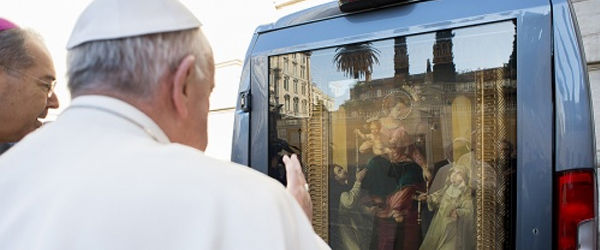On the last Sunday in June — the weekend of the feast of Corpus Christi — members of St. Francis Xavier Chapel in Little Tokyo traveled to Manzanar, the site of the Japanese relocation center/internment camp where, from 1942 to 1945, some 11,000 Japanese Americans were interned during World War II. In attendance this day (which included Mass, a picnic lunch and a tour of the National Park Service’s Historic Site and Interpretive Center at Manzanar) were the parish youth group, which had gone on a camping trip in the area; Father Richard Hoynes, parish administrator; and adult parishioners, some of whom had lived in the camp created in 1942 by President Franklin D. Roosevelt’s Executive Order 9066.Manzanar housed many of Japanese descent from Los Angeles who had been members of the Maryknoll Center at St. Francis Xavier Church in Los Angeles before WWII. During the war, the Maryknoll priests and sisters who served at the parish also “relocated” themselves to Manzanar or to nearby Lone Pine. There they celebrated daily Mass, administered the sacraments, visited with parishioners and saw to their needs. In many cases the “Maryknolls” were the ones who represented the people to the camp superintendents. In 1943, Maryknoll Sisters Bernadette Yoshimochi and Anna Hayashi — having been told they could go back to their Maryknoll headquarters on the East Coast rather than go to the internment camp — chose to stay with their parishioners and lived inside the camp for the duration. Maryknoll Fathers Leo Steinbach and Hugh Lavery, who also were responsible for the chapel in Los Angeles, stayed in Lone Pine and went to Manzanar every day. Life in the camps was spartan at best. The barracks each housed a number of families and the only privacy afforded them was sheeting to hang around their beds. The barracks’ canvas sides and roofs made the occupants feel the extreme cold and wind of the desert, as well as the blowing dirt and sand. Latrines were shared by large numbers of people.For the current St. Francis Xavier parishioners who came to Manzanar in June, it was an understandably quieting and reflective experience. Many spent time in the camp’s cemetery at Manzanar, where some who died during the war are still buried, although many bodies have been re-claimed by families. What drew the attention of all was the monument designed and constructed in 1943 by Ryozo Kado, a master stonemason and St. Francis Xavier parishioner who worked for the Los Angeles Archdiocese from the 1930s (he constructed the Lourdes grotto at St. Elizabeth of Hungary Church in Altadena, and many features at Holy Cross Cemetery in Culver City including the pond and Lourdes-inspired shrine) until his death at 92 in 1982. At Manzanar Kado designed and constructed gardens around the barracks building, including water gardens, and built the main guardhouse at the entrance. When asked to build the monument at the cemetery, he replied that he would do it only if he received approval from all the internee families. The families each gave 15 cents for the project, which includes an inscription in Japanese: I REI TO. Literally translated it means: “soul consoling tower.” The visitors from Los Angeles were joined this day for Mass at the original site of the Barracks 25 church by Manzanar Park Superintendent Leslie Inafuku and his wife. They told the group that, to the park service’s best knowledge, no other Mass has been celebrated at the site since the camp closed 66 years ago.One of the visitors wore a cap denoting service in WWII as a member of the famed 100th/442nd regiment made up entirely of Japanese American soldiers who were sent to European/North African combat zones. Manzanar documents say that nearly all Japanese soldiers were assigned to this regiment which became one of the most highly decorated Army units for its size and length of service. Possibly, that was one reason why, at the end of the liturgy, all joined together to sing two verses of “America the Beautiful.” {gallery width=100 height=100}gallery/2011/0819/manzanar/{/gallery}

